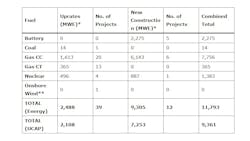PJM Interconnection Selects 51 Generation Resource Projects to Address Near-Term Electricity Demand Growth
PJM Interconnection has selected 51 projects to provide more than 9,300 MW of reliable capacity through the Reliability Resource Initiative (RRI).
The projects include 39 uprates and 12 new construction proposals. The uprates apply to existing natural gas, nuclear, coal and onshore wind resources. Of the new projects, half are gas, five are batteries and one is nuclear.
The uprates total 2,108 MW of unforced capacity (UCAP), or the amount of energy a resource is expected to provide during times of highest system reliability risk. The new projects are predicted to contribute 7,253 MW of UCAP, for a combined total of 9,361 MW.
While most of the projects, or 90%, are expected to be online by 2030, all are projected to be operational by 2031. The projects were selected from 94 applicants using a weighting process assigning the most value to UCAP and in-service date, followed by Effective Load Carrying Capability (which values a resource's contribution to reliability) and additional consideration for locating in zones for generation.
PJM had planned to limit the number of projects in the initiative to 50, but a tie in the weighted scoring system for the last two projects resulted in 51 projects being selected.
PJM is moving toward completion of the transition period of the reformed interconnection process, which has produced 18,000 MW worth of projects with signed interconnection agreements through PJM's Fast Lane, for projects with lesser impact on the system. These are among approximately 47,000 MW in projects that have completed PJM's interconnection process and are allowed to move to construction and operation.
The projects that are part of the Reliability Resource Initiative will be studied as part of the final transition phase of PJM's interconnection process reform. In addition to the RRI projects, PJM will complete processing on approximately 62,000 MW projects in 2025 and 2026.
PJM's new Cycle process for projects looking to interconnect with the system will start in spring 2026, with a process time of one to two years.
PJM has acted to mitigate the risk of having inadequate generation resources to serve rapidly increasing electricity demand. These actions include:
- Automation – Additional automation in the interconnection process, along with increased staffing over the past several years, has improved quality while reducing the backlog by 60%. PJM also announced a multiyear collaboration with Google and Tapestry to deploy AI-enhanced tools to further streamline PJM's planning process for connecting new generation resources to the grid.
- Surplus Interconnection Service – PJM obtained FERC approval to streamline the use of the unused portion of interconnection service for facilities that cannot or do not operate continuously, every hour of every day, year-round (such as adding battery storage to a renewable site).
- Capacity Interconnection Rights Transfer – A reform package endorsed by PJM stakeholders and currently pending review by FERC would facilitate an expedited interconnection process for a replacement resource seeking to use the capacity interconnection rights of a retiring resource.
PJM is requesting states to work with developers to help get generation constructed once it has cleared PJM's study process.
